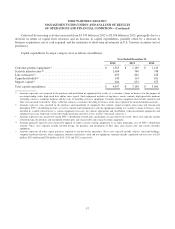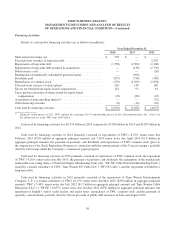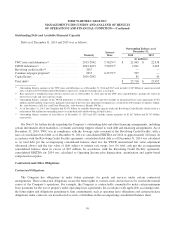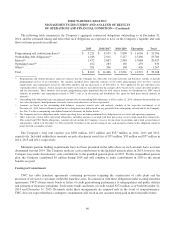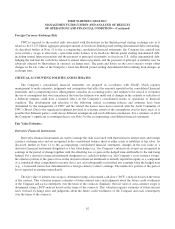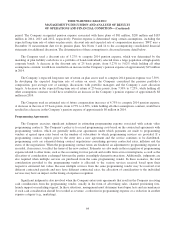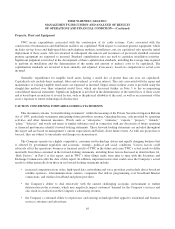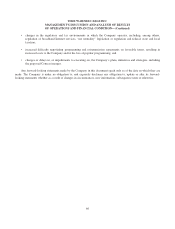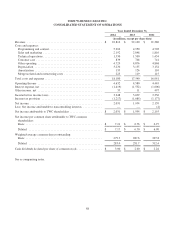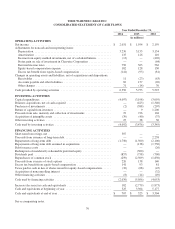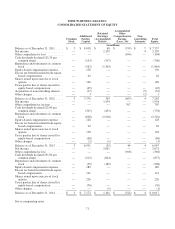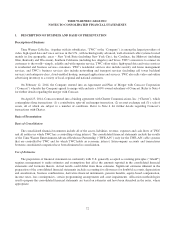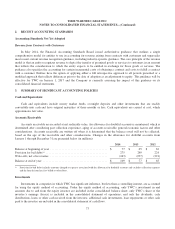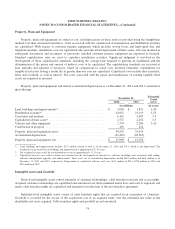Time Warner Cable 2014 Annual Report Download - page 73
Download and view the complete annual report
Please find page 73 of the 2014 Time Warner Cable annual report below. You can navigate through the pages in the report by either clicking on the pages listed below, or by using the keyword search tool below to find specific information within the annual report.TIME WARNER CABLE INC.
MANAGEMENT’S DISCUSSION AND ANALYSIS OF RESULTS
OF OPERATIONS AND FINANCIAL CONDITION—(Continued)
Property, Plant and Equipment
TWC incurs expenditures associated with the construction of its cable systems. Costs associated with the
construction of transmission and distribution facilities are capitalized. With respect to customer premise equipment, which
includes set-top boxes and high-speed data and telephone modems, installation costs are capitalized only upon the initial
deployment of these assets. All costs incurred in subsequent disconnects and reconnects of previously installed customer
premise equipment are expensed as incurred. Standard capitalization rates are used to capitalize installation activities.
Significant judgment is involved in the development of these capitalization standards, including the average time required
to perform an installation and the determination of the nature and amount of indirect costs to be capitalized. The
capitalization standards are reviewed at least annually and adjusted, if necessary, based on comparisons to actual costs
incurred.
Generally, expenditures for tangible fixed assets having a useful life of greater than one year are capitalized.
Capitalized costs include direct material, labor and overhead, as well as interest. The costs associated with the repair and
maintenance of existing tangible fixed assets are expensed as incurred. Depreciation on these assets is provided using the
straight-line method over their estimated useful lives, which are discussed further in Note 3 to the accompanying
consolidated financial statements. Significant judgment is involved in the determination of the useful lives of these assets
and is based upon an analysis of several factors, such as the physical attributes of the asset, as well as an assessment of the
asset’s exposure to future technological obsolescence.
CAUTION CONCERNING FORWARD-LOOKING STATEMENTS
This document contains “forward-looking statements” within the meaning of the Private Securities Litigation Reform
Act of 1995, particularly statements anticipating future growth in revenue, Operating Income, cash provided by operating
activities and other financial measures. Words such as “anticipates,” “estimates,” “expects,” “projects,” “intends,”
“plans,” “believes” and words and terms of similar substance used in connection with any discussion of future operating
or financial performance identify forward-looking statements. These forward-looking statements are included throughout
this report and are based on management’s current expectations and beliefs about future events. As with any projection or
forecast, they are subject to uncertainty and changes in circumstances.
The Company operates in a highly competitive, consumer and technology driven and rapidly changing business that
is affected by government regulation and economic, strategic, political and social conditions. Various factors could
adversely affect the operations, business or financial results of TWC in the future and cause TWC’s actual results to differ
materially from those contained in the forward-looking statements, including those factors discussed in detail in Item 1A,
“Risk Factors,” in Part I of this report, and in TWC’s other filings made from time to time with the Securities and
Exchange Commission after the date of this report. In addition, important factors that could cause the Company’s actual
results to differ materially from those in its forward-looking statements include:
• increased competition from video, high-speed data, networking and voice providers, particularly direct broadcast
satellite operators, telecommunications carriers, companies that deliver programming over broadband Internet
connections, and wireless broadband and phone providers;
• the Company’s ability to deal effectively with the current challenging economic environment or further
deterioration in the economy, which may negatively impact customers’ demand for the Company’s services and
also result in a reduction in the Company’s advertising revenue;
• the Company’s continued ability to exploit new and existing technologies that appeal to residential and business
services customers and advertisers;
65




